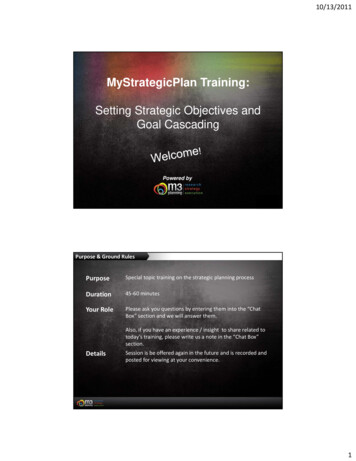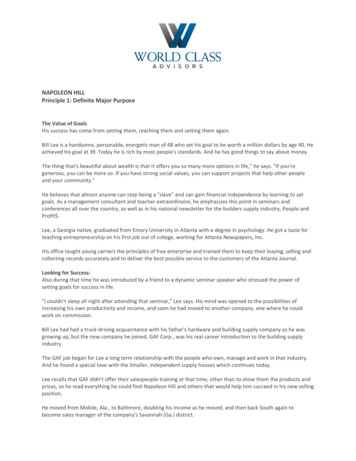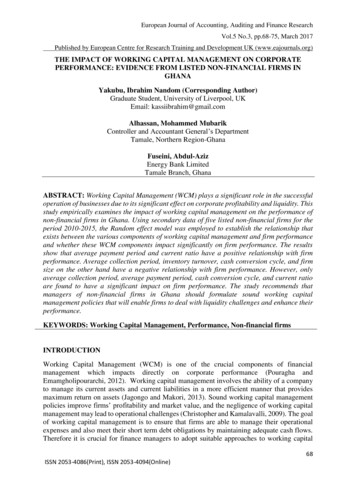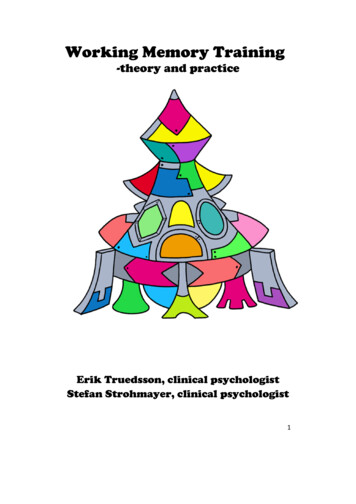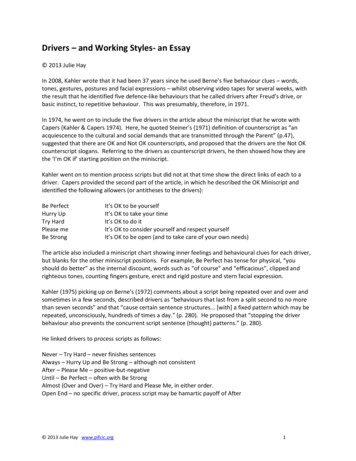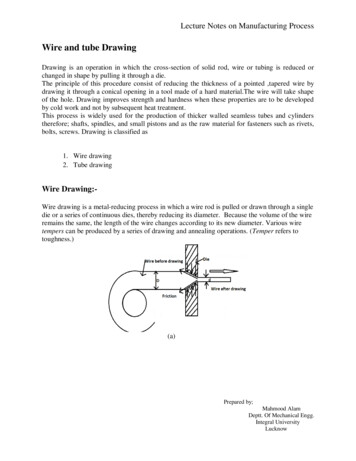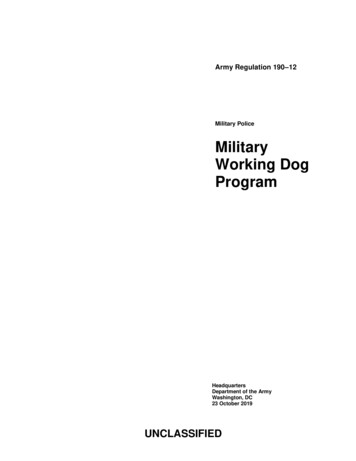
Transcription
Working On Purpose:Setting and Achieving Goals, and Managing TimeMore SuccessfullyRLI Design ProfessionalsDesign Professionals Learning EventDPLE 273September 2, 2015
RLI Design Professionals is a Registered Provider with TheAmerican Institute of Architects Continuing EducationSystems. Credit earned on completion of this program will bereported to CES Records for AIA members. Certificates ofCompletion for non-AIA members are available on request.This program is registered with the AIA/CES for continuingprofessional education. As such, it does not include contentthat may be deemed or construed to be an approval orendorsement by the AIA of any material of construction orany method or manner of handling, using, distributing, ordealing in any material or product. Questions related tospecific materials, methods, and services will be addressedat the conclusion of this presentation.
Copyright MaterialsThis presentation is protected by US and InternationalCopyright laws. Reproduction, distribution, display anduse of the presentation without written permission ofthe speakers is prohibited. RLI Design Professionals
Course DescriptionIn this course we learn how to manage time andenergy more effectively to achieve greaterresults with less effort and to successfully setand achieve goals. This includes using the 80/20rule, entrepreneurial time managementprinciples, fine-tuning how we manage our to dolists - all with the purpose of setting andachieving clearly defined, written goals andobjectives.
Learning ObjectivesParticipants will:Learn the importance of goals and how to detail them in writing;Review effective elements of goal setting;Discover how to use Time and Energy More Efficiently; andUnderstand how to get better results with the To Do List and the80/20 Rule.
Working on PurposeWritten & Presented by:J. Kent Holland, J.D.Kent@KentHolland.com703-623-1932Copyright 2003-2013, Kent Holland,Vienna VA
Part 1:Setting & Achieving Goals
Setting & Achieving GoalsWhen not seeking goals we begin to stagnate. Only 3 percent of Americans specifically commit their goals topaper. In a study at Yale in 1953, researchers interviewed graduatingclass members and found less than 3 percent establishedgoals or a plan. A follow-up study of that class in 1973, found the group withestablished goals were better adjusted emotionally, socially,and economically. Moreover, the 3 percent with goals wereworth more than the other 97 percent of the class memberscombined.
Setting & Achieving GoalsGoals: What they do for usGive us a sense of meaning, purpose and direction.Enable us to live in present while planning for future.Promote our enthusiasm and persistence.Help us to prioritize and make us more effective and efficient.Provide us a means to evaluate our progress.Help us communicate what we want and need.
Setting & Achieving GoalsElements of Effective Goal SettingSet goals that come out of your heart – your passion.Set goals big enough to motivate you but realistically achievable.State goals as positive statements of what you’re doing.State goals in great detail.Set long-range goals. Break them down as short-term goals and activities you can begin today.Set goals to be met on a daily basis.Share goals with others who will encourage, support and help you, as well as hold youaccountable.Measure and keep track of your progress in achieving your goals.
Setting & Achieving GoalsHow Big are Your Goals?Goals should be bigenough that they createsufficient excitement tomotivate us to accomplishthemIn Good to Great, JimCollins calls theseBig, Hairy, AudaciousGoals (BHAG)
Setting & Achieving GoalsGoals: Long and ShortSet long-range goals, andthen get started doingshort-term activitiesconsistent with the longrange goal.By visualizing into thefuture you will morelikely overcome shortterm roadblocks.Keep the big picturealways in front of you.
Setting & Achieving GoalsState Your Goals with SpecificityThe more descriptively you state thegoal, the more real the goal will becometo your subconscious mind and the moreingrained it will become in your psyche.The more you begin to experience theoutcome from this goal as already beingreality, the greater the likelihood that itwill become true.Goals must be specific and focused.“I’m driving my new, silver, Chrysler Convertible by this coming Spring.”
Setting & Achieving GoalsChunking Goals Down to SizeTo write a book, I writespecific goals on“White Board” in myoffice. (also on my “ToDo” list on computer)See them every day as Isit at my deskCreate monthly, weeklyand daily “To Do” listsfor the variousactivitiesSet deadlines andmeasure progressCreate Master plan“ToDo” list to accomplishsubparts of each goal
Setting & Achieving GoalsOrganizing “To Do” List Around GoalsSet long-range goals,and then create longterm “To Do” activitiesconsistent with thosegoalsKeep the big, futurepicture always in frontof youA large goal becomesreachable when it isbroken down into dailyincrements of daily “ToDo” itemsThe big projects arethus broken down intomanageable tasksSet Yearly, Monthly andWeekly Goals and “ToDo’s”
Setting & Achieving GoalsGoals are most effective when they are stated aspositive statements. State affirmatively what you want to movetoward instead of negative goals of whatyou want to stop doing or move away from. Be certain that your focus is on what youwant.
Setting & Achieving GoalsSet Goals to be Met on a Daily Basis Unless we chunk the big goal down intomanageable daily goals, they will remainnothing more than a day-dream. How do you eat an elephant?
Setting & Achieving GoalsShare Your Goals with Others We need positive feedback to assure us thatwe’re on the right track. It helps to have others acknowledge ourprogress. Success begets success.
Setting & Achieving GoalsEstablish a way to measure how you are doing inachieving your goals. It’s easier to measure accomplishment of specificdetails than it is vague generalities. We need language precisely defining what we wantand how we will know when we have gotten it. Otherwise our goals will be meaningless generalitiesthat do not pull us forward into action.
Setting & Achieving GoalsPlanning for the Long-Term, but with Manageable Time PeriodsThe Valueof a ThreeYear PlanBalance AllAreas ofLifeEvaluateWhetherTime SpentisConsistentwith GoalsVisualizeReachingYour Goal
Part 1:Exercises
Goals Exercise #1: Writing Down Your Goals1) Write down all your goals. If time, money and ability were not an issue,and nothing could stop you from succeeding, what goals and activitieswould you accomplish? Just write down anything that comes to mind.Don’t think too hard on this.– Short-term—to accomplish as soon as possible– Intermediate-term—to accomplish within 3 years– Long-term—to accomplish in your lifetime2) Prioritize the Goals you listed.
Goals Exercise #2: Refining Goals to Positive Statements1) Re-write the top two or three goals from each group (short-term, midterm, long-term).2) Write them as positive statements of what you are accomplishing (Putyourself in the place where you are already accomplishing your goals anddescribe them from that perspective);– Make these statements as detailed and specific as you can imagine;and– State the time period in which you are accomplishing these goals.
Goals Exercise #3: Long-Term Goals Beget Intermediate Short-Term Goals1) As you review your long-term goals you will want to chunk them downfurther into milestones or short-term goals that need to be accomplishedalong the way to achieve your long-term goals.2) Write down short and intermediate-term goals (not already listed in yourprevious exercises) that will be needed for you to achieve the long-termgoals. State them in the same positive format.
Goals Exercise #4: Strengths & Resources1) For each goal you wrote down, list strengths and resourcesyou will need to accomplish them.2) For each of these strengths and resources, write down whatspecific activities you can do to improve on them and usethem to better assure your success in achieving the goals.
Goals Exercise #5: Weaknesses & Barriers to Overcome1) For each of your important goals, list any personal weaknesses or barriersthat may get in the way of accomplishing them. Examples might be things like these: “low energy,” “poor physicalfitness,” “unorganized,” “poor use of time,” “addictions,” “temper,” or“not enough education.”2) Make a list of Weaknesses and Barriers that you feel may be standing inyour way of achieving your goals.
Goals Exercise #6: Developing Good Habits to Overcome Weaknesses1) Referring to the list you made in the last exercise, make a list or table thathas three column headings.– In column #1: “Weakness/Barrier,” list each weakness or barrier youidentified in the previous exercise.– In column #2: “Positive Opposite,” re-state each negative barrier as itspositive opposite.– In column #3: “Positive New Habits,” list positive habits you aredeveloping to pull you into the desired change.“I’m going to the gym three times a week.”
Goals Exercise #7: Accountability1) Keep track of how well you are following through with your planned newpositive habits.2) Take the list of positive new activities and habits you noted for yourself inprevious exercises and post them someplace where you will see themfrequently.– On a calendar, a “to do” list, a wall, a refrigerator door, or above yourdesk.– Make a check mark or note on the list when you do the activities forgrowing positive habits.
Part 2:Managing Time & EnergyMore Effectively
Managing Time & Energy More EffectivelyManaging Time Consistent with Our GoalsPart 1 of this workshop addresses “Goals.”Useful to first evaluate how we use time. Then our “goals”become more apparent from what we do with our time.Evaluate whether our goals and time utilization areconsistent with each other.Our time must be managed so as to achieve our goals.Otherwise, we may accomplish a lot of “to do” items butfeel frustrated, unfulfilled, unsatisfied, because no sense ofaccomplishment of things that matter the most.Can result in increased effort (spinning our wheels), burningout and giving up – even becoming depressed.
Managing Time & Energy More EffectivelyPrioritize our Time (and Goals)If we pursue every opportunitythat is available we will diluteour energy and efficiencyIdentify and tackle the “BigRocks” before doing the lessimportant and mundane. “BigRocks” is the term coined byStephen Covey - First ThingsFirst
Managing Time & Energy More EffectivelyDealing with Time BarriersSome of the most significant time barriers we create include:Disorganization,Failing to say “No,”Trying to do too much in too little time,Lacking self-discipline,Being indecisive,Procrastinating,Not finishing the tasks we start, andA little too much socializing.
Managing Time & Energy More EffectivelyDealing with More Time BarriersOur environment can also interfere with good use of time:E-mail and internet,Phone calls and text messages,Co-workers and visitorsstopping by,Meetings,Information gaps,Paperwork, andInefficient staffing.
Managing Time & Energy More EffectivelyTracking where time goes Do you find yourself wondering where thetime went?Make a list and 3 times a day just jot downwhat you did in the previous hours.May be surprised to find an hour got used upchecking email over and over again or surfingthe news, or in performing insignificant tasksnot related to your “Big Rocks.”
Managing Time & Energy More EffectivelyThe Classic “TO DO” list – Still an Effective ToolNothing could be simpler than putting intowriting what we plan to do.It doesn’t require fancy books or computerprograms.A simple paper pad, word processing program,or smart phone “app” will do just fine.Calendar the items with specific dates andtimes for action.
Managing Time & Energy More EffectivelyWhat to Include on Your “To Do” ListStart with a Big Rockbefore taking a break tomake phone calls, readmail, and performnecessary time-sensitiveactivitiesList only the few bigitems that must be doneAs you think ofsecondary items relatingto the big items, addthemBy putting fewer itemson list, you’re morelikely to focus on themand get them doneDon’t clutter up the listwith too many items
Managing Time & Energy More EffectivelyInclude Work, Family & PlayTime with family,friends, religiousactivities, sports, andanything else you wantto do can be on the listTreat weekend timeand activities just asimportant as weekdayactivitiesPlan leisure time justas we do work-timeInclude physical,emotional and spiritualaspects of lifeGET BALANCED!STAY BALANCED!
Managing Time & Energy More EffectivelyPlanning the Amount of Time NeededEverything takes longer than anticipated.Don’t put 10 items down for a single day if it is impossible to do thatmany. Spread them out realistically. Or list them in separate column of projects and activities to be done in due course.Keep the daily list REALISTIC. Looking at impossible “to achieve” lists can cause despair or distress.
Managing Time & Energy More EffectivelyHow Do We Measure Productivity?Productivity is measured in terms of whetherwe accomplish our primary goals and theactivities that support those goals. If we fillour day with dozens of activities that wediligently check off our list, but we don’t get toour Big Rocks, we have failed!
Managing Time & Energy More EffectivelyFlexibility & Spontaneity Enhanced in PlanningPlan your work and work your plan Liberates us to be constructively spontaneous. Gives us freedom to do unplannedthings. Knowing we are meeting our plan let’s us feel comfortable putting aside plannedactivities so we can do important, but unplanned, things that come up. Empowers us to take time out to spend on other activities because we know weare accomplishing our Big Rocks. Don’t become a slave to your plan and follow it with such fervor that you fail torespond to good opportunities that arise.
Managing Time & Energy More EffectivelyWhat is the 80/20 Rule?Vilfredo Pareto – 1897“Pareto Principle”He found 20 percent ofany given population,of any country duringany time period,accounted for 80% ofthe wealth.
Managing Time & Energy More EffectivelyWhy Does 80/20 Matter to Us?The 80/20 Rule reveals there is generally asignificant imbalance between our effortsand our results.20 percent of our efforts produce 80percent of the results.The other 80 percent efforts produce 20percent of the results & might evendetract from the results produced by thevaluable 20 percent time.
Managing Time & Energy More EffectivelyApplying 80/20 RuleSeek to be excellent in afew things – not good atmany.Do only what you’rebest at and enjoy most.Determine the 20percent effort thatproduces the 80 percentreturn (in every part ofyour life).Don’t chase everyopportunity. Work lessby applying your timeand energy only to keyvaluable goals.Look for the efficientshort cuts.Learn to say No.
Managing Time & Energy More EffectivelyMore 80/20 Insights 80 percent of whatyour organizationdoes yields no morethan 20 percent ofthe benefit to yourcustomers.80 percent of thevalue perceived bycustomers derivesfrom 20 percent ofthe activities ofyour firm.80 percent of thebenefit from anyservice can beprovided at 20percent of the cost.80/20Rule80 percent of anyindustry’s profitscome from 20percent of itscustomers.
Managing Time & Energy More EffectivelyApply 80/20 to All Aspects of LifeThe rule applies at work, family, friends, play,etc.Directly applies to how successful you will beat accomplishing your goals and mission.This is true whether your mission is running ahappy family or successful business, or a nonprofit entity or charitable work.
Managing Time & Energy More EffectivelyFinal Thoughts on Managing Time & EnergyRather than seek marginal improvement in efficiency through time management, we need toquit some current activities and replace them with ones of greater impact and value.Our problem isn’t lack of time. It is that we busy ourselves with unnecessary 80% activitiesinstead of the 20% that count the most.Figure out which activities support our “Big Rocks” and concentrate on those.Take time for strategic planning, goal setting, managing time consistent with ourpurpose/mission.By conforming time management skills to 80/20 rule we will get greater success with lesseffort and stress.
Part 2:Exercises
Time Exercise #1: Creating “To Do” List1) Take about ten minutes to review your responsibilities (to work, family,community, and self), appointments, key objectives, goals, and any plannedactivities for the next two weeks. Prioritize these into a list – and put the “BigRocks” first.2) Using the list developed in number 1, create a basic “To Do” list for what youwant to accomplish in the next week. (This is not detailed. The details followin item 3 below).3) Referring to your plan from item 2, create a “To Do” list for each day of thecoming week. This will include priority items, chores and calls you don’t wantto forget, and appointments.
Time Exercise #1 - continued4) As you complete your day using the “To Do” list, move the uncompleted itemsforward to another day.5) Create a weekend “To Do” list to remind you of activities you may be planningwith your family or friends.6) At the end of the week, look over your completed “To Do” lists.– Think about why some items went undone.– Is there something to do differently to get them done?– Do they really deserve the priority you thought they did?
Time Exercise #1 - continued7) After doing the thoughtful review of what was accomplished and whyyou did not do some of the items you listed:– Make a new plan and “To Do” list the next week; and– Follow each of the steps in items three through six again for thesecond week.8)At the end of the second week, reflect upon your experience and write ashort paragraph stating:– What specific and practical things you learned; and– How you will implement this on an on-going basis.
Time Exercise #2: Overcoming Procrastination1) Write down a specific, detailed goal for a project you have been puttingoff – and include time period to accomplish it.2) If this is large or complex project, break it into logical small activities,tasks, or subparts (big rock chunk down) – and list each activity.3) List the steps needed to start the project (including the activities, tasksand subparts you identified in step 2).4) Set a time for doing the steps.5) Do it!
Time Exercise #3: Changing Time Wasting Activities1) Identify the time-wasters impacting your day.2) List the most significant of these.3) Then write down the positive steps you will take to form newhabits.4) Keep track of how you are doing with your new habits.
Time Exercise #4: Track Where the Time Goes1) Three times each day, jot down as bullet items everythingyou’ve done in the preceding hours.– Don’t do this any more often than three times a day or itwon’t work.2) At the end of the day, look over what you did and considerwhat can be done differently, and what you will dodifferently.
Time Exercise #5: Finding the 80/20 in Everything We Do1. Look for the powerful 20 percent in everything you do.– Inventory what you’re doing in work and non-workactivities that constitute your most powerful 20 percent.2. List what immediately comes to mind concerning what youcan do right now to move your time, talents, and money intothe 20 percent activities and eliminate as much as you canthat is in the 80 percent activities.80/20 Rule
About the Author/Presenter Kent Holland is a construction lawyer and risk managementconsultant. Author of 10 books and dozens of papers and articles. Speaker for conferences, retreats, seminars, andworkshops. His book, Working on Purpose, is available from Amazon.com His websites include: www.ConstructionRisk.com www.KentHolland.com Contact: Kent@KentHolland.com 703-623-1932
This concludes The American Institute of ArchitectsContinuing Education Systems ProgramLaurel Tenuto, Client Risk Management CoordinatorLaurel.Tenuto@rlicorp.comMarie Bernier, Senior Risk Management ConsultantMarie.Bernier@rlicorp.com
Setting & Achieving Goals Set long-range goals, and then create long- . It doesn’trequire fancy books or computer programs. A simple paper pad, word processing program, or smart phone “app” will do just fine. Cal




